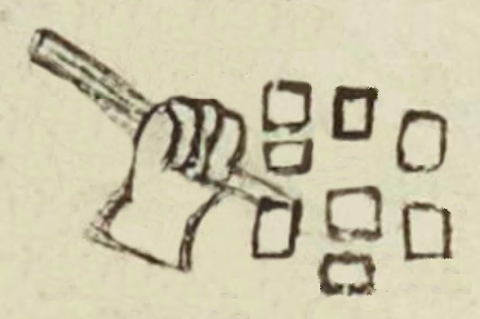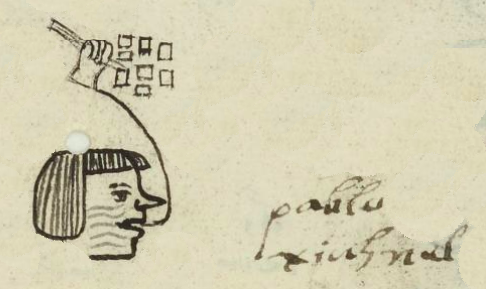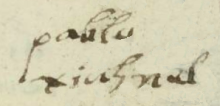Xiuhnel (MH631v)
This black-line drawing of the simplex glyph for the personal name Xiuhnel ("Incapable," "Cloud Serpent," or "Morning Star") shows a group of what is presumably turquoise (xihuitl) tesserae, pieces that would be used in mosaics. There are eight pieces, all of them small squares or rectangles. The xihuitl serves as a phonetic indicator for the start of the name (Xiuh-).To the left of the mosaic pieces is a human hand grasping a writing implement that is pointing at the tesserae. Its role in the interpretation of this glyph remains to be seen.
Stephanie Wood
The small rectangular shapes of this glyph are likely turquoise pieces of the type that were used in mosaics (tesserae). Some MH examples of the name Xiuhnel have turquoise-blue coloring which supports this interpretation for the lot of them. For extensive examples of turquoise tesserae, see the appendices of Conceptualization of 'Xihuitl' (2008), by Matzumi Izeki. This collection also includes an iconographic example of turquoise (xihuitl) that shows pieces of the stone made into a small, round mosaic (below).
For some excellent examples of turquoise mosaics from Mexico that are in the British Museum, see Elizabeth M. Carmichael, Turquoise Mosaics from Mexico (London: Trustees of the British Museum, 1970) and Colin McEwan et al, Turquoise Mosaics from Mexico (Durham: Duke University Press, 2006).
At first glance the name Xiuhnel appears to be a compound of xihuitl (turquoise) and nelli (true). James Lockhart suggests that -nel-, when in combinations, could lose that meaning, as noted in the OND under the term nelli. According to popular belief, Xiuhnel and Mimich were two of hundreds of Cloud Serpents associated with hunting, promiscuity, and drunkenness. See The Fate of Earthly Things by Molly H. Bassett (2015, 175). The translators of the Primeros Memoriales say that Xiuhnel and Mimich were prominent figures in many migration stories of central Mexican cultures. See the Sullivan and Nicholson edition of the PM (1997, 135). Some also say Xiuhnel is the morning star. If so, then the rectangular shapes in this glyph may relate to that. But there is also a xiuhnel meaning "incapable," according to A. Wimmer (2004) (included in the Gran Diccionario Náhuatl).
Stephanie Wood
pablo
xiuhnel
Pablo Xiuhnel
1560
Jeff Haskett-Wood
turquesa, teselas, estrellas, mosaics, mosaicos, estrella de la mañana, rectángulos, cuadros, serpiente de las nubes, incapaz, nombres de hombres, hands, manos, writing, escribir, escribiendo

Xiuhnel, name, incapable, Cloud Serpent, or Morning Star, https://nahuatl.wired-humanities.org/content/xiuhnel
xihui(tl), turquoise, https://nahuatl.wired-humanities.org/content/xihuitl-0
nel(li), true, https://nahuatl.wired-humanities.org/content/nelli
Incapaz, La Estrella de la Mañana, o La Serpiente de las Nubes
Stephanie Wood
Matrícula de Huexotzinco, folio 631r, World Digital Library, https://www.loc.gov/resource/gdcwdl.wdl_15282/?sp=345st=image.
This manuscript is hosted by the Library of Congress and the World Digital Library; used here with the Creative Commons, “Attribution-NonCommercial-ShareAlike 3.0 License” (CC-BY-NC-SAq 3.0).








